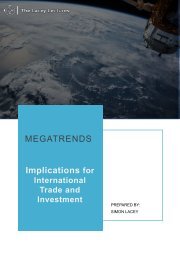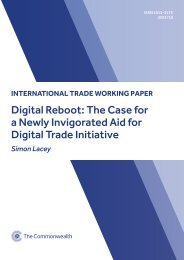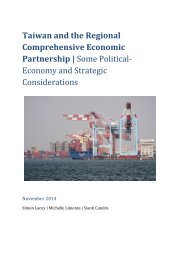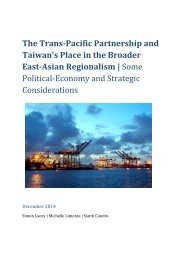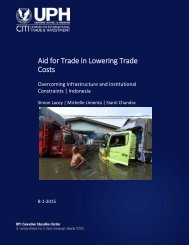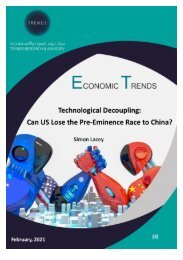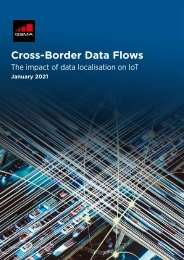White Paper Trade Rules and the Digital Economy Key Points and Findings
This synopsis document summarizes and articulates the key points and findings from the much longer 2017 White Paper on Trade Rules for the Digital Economy.
This synopsis document summarizes and articulates the key points and findings from the much longer 2017 White Paper on Trade Rules for the Digital Economy.
- No tags were found...
Create successful ePaper yourself
Turn your PDF publications into a flip-book with our unique Google optimized e-Paper software.
Huawei | <strong>Trade</strong> <strong>and</strong> <strong>the</strong> <strong>Digital</strong> <strong>Economy</strong><br />
EXECUTIVE SUMMARY<br />
Our <strong>White</strong> <strong>Paper</strong> on <strong>Trade</strong> <strong>Rules</strong> for <strong>the</strong> <strong>Digital</strong><br />
<strong>Economy</strong> represents a first attempt by Huawei to<br />
exercise thought leadership in a relatively new<br />
area of international rule‐making. The current set<br />
of international trade rules largely predates <strong>the</strong><br />
internet era of <strong>the</strong> last two decades. An update<br />
of <strong>the</strong> “analogue rules” to bring <strong>the</strong>m into <strong>the</strong><br />
digital age is long overdue but has run into some<br />
unexpected headwinds as of late. Our <strong>White</strong><br />
<strong>Paper</strong> is an attempt to express our views on how<br />
we see <strong>the</strong> current debates surrounding new<br />
trade rules, with <strong>the</strong> hope of making a modest<br />
contribution to producing outcomes that would<br />
guarantee future decades of <strong>the</strong> breathtaking<br />
growth we have seen in <strong>the</strong> digital economy <strong>and</strong><br />
<strong>the</strong> unleashing of pent‐up innovation, as well as<br />
<strong>the</strong> seizing of manifold opportunities as millions<br />
have become empowered in <strong>the</strong> developing<br />
world to set <strong>the</strong>mselves free from poverty.<br />
The first Chapter of our <strong>White</strong> <strong>Paper</strong> defines <strong>the</strong><br />
digital economy as <strong>the</strong> range of goods, products,<br />
services <strong>and</strong> solutions that have emerged <strong>and</strong><br />
continue to emerge in direct relation to online<br />
connectivity. This definition admittedly covers a<br />
broad value chain ranging from <strong>the</strong> hardware<br />
<strong>and</strong> equipment constituting <strong>the</strong> backbone<br />
infrastructure of telecommunications networks,<br />
to <strong>the</strong> devices, particularly smart phones, tablets,<br />
wearables, computers <strong>and</strong> o<strong>the</strong>r terminals used<br />
in order to get <strong>and</strong> stay online. This definition<br />
also comprises <strong>the</strong> various services, solutions<br />
<strong>and</strong> applications that have emerged to meet <strong>the</strong><br />
many needs that users place on <strong>the</strong> internet <strong>and</strong><br />
<strong>the</strong> whole online ecosystem, including digital<br />
products <strong>and</strong> services such as software <strong>and</strong> e‐<br />
books. In laying out this definition, we will look<br />
beyond <strong>the</strong> narrow confines of focusing simply<br />
on e‐commerce, but ra<strong>the</strong>r examine how<br />
digitalization has transformed international<br />
trade across borders: Chapter 1 looks to define<br />
<strong>and</strong> elucidate <strong>the</strong> emergence of modern day<br />
digitalized global value chains that are having a<br />
disruptive <strong>and</strong> transformative effect on both <strong>the</strong><br />
way businesses operate as well as how<br />
consumers acquire <strong>and</strong> use products, services<br />
<strong>and</strong> information.<br />
Chapter 2 of our <strong>White</strong> <strong>Paper</strong> examines Huawei’s<br />
place in <strong>the</strong> digital economy. Across all of our<br />
three business groups, we occupy a unique place<br />
in <strong>the</strong> digital economy in terms of product<br />
coverage, but also in terms of our geographical<br />
footprint, since we operate in both very<br />
underdeveloped as well as very technologically<br />
advanced markets. With regard to our core<br />
carrier business, we are responsible for building<br />
<strong>the</strong> underlying network infrastructure (pipe) that<br />
allows <strong>the</strong> digital economy to function in <strong>the</strong> first<br />
place. When it comes to our enterprise business,<br />
we provide a range of new services <strong>and</strong> solutions<br />
that leverage <strong>the</strong> power of cloud computing <strong>and</strong><br />
remotely serviced platforms, such as in <strong>the</strong> area<br />
of digital customs, or our many Smart City<br />
solutions. Finally in our devices business, where<br />
we are contesting global smartphone, tablet <strong>and</strong><br />
wearables markets, we operate as a seller of <strong>the</strong><br />
terminals with which users interface with <strong>the</strong><br />
digital economy in order to purchase <strong>and</strong>/or<br />
consume <strong>the</strong> services, solutions, products <strong>and</strong><br />
information that <strong>the</strong> digital economy offers. As<br />
such, we are potentially vulnerable to changes in<br />
<strong>the</strong> underlying legal, regulatory <strong>and</strong> policy<br />
regimes that govern <strong>the</strong> many stages of <strong>the</strong><br />
digital value chain. Chapter 2 discusses several<br />
ways in which new <strong>and</strong> existing trade <strong>and</strong><br />
investment rules affect different aspects of our<br />
business.<br />
Chapter 3 focuses on <strong>the</strong> underlying legal <strong>and</strong><br />
regulatory environment in which companies like<br />
Huawei operate. As in many o<strong>the</strong>r fields of <strong>the</strong><br />
law, <strong>the</strong> current rules are struggling to keep pace<br />
with technological developments <strong>and</strong> <strong>the</strong> quick<br />
pace of innovation that characterizes <strong>the</strong><br />
technology sector in particular. Many countries<br />
are enacting rules <strong>and</strong> setting up regulatory<br />
regimes that have a direct impact on <strong>the</strong> digital<br />
economy. Whe<strong>the</strong>r it be with <strong>the</strong> objective of<br />
better protecting <strong>the</strong> data privacy of <strong>the</strong>ir<br />
citizens, beefing up national law enforcement<br />
2




